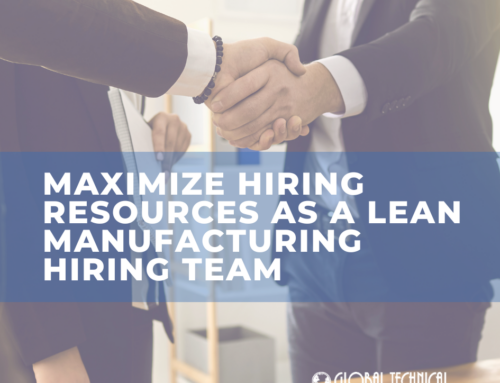Manufacturers are looking to hire not only a new wave of workers into the ranks of the industry, but are also looking for the right kind of skilled talent. And it is proving to be more difficult than before. There has been a clear employment gap for years now as the baby boomer generation is phasing out, but it’s now coming to a head with a skill deficiency in the workforce. With advancements in technology and IoT has caused manufacturers to really get serious about finding that top talent with the right skills.
The time is now for manufacturers to dive into a process of understanding how their current employees could be viable candidates for jobs that will change with a change in the industry. One of the talent management strategies of top manufacturers in 2021 is upskilling and reskilling initiatives. These are also key components of successful employee retention and engagement programs.
But first, let’s talk about upskilling & reskilling and why they are not the same thing (but both are very important!)
Upskilling is taking your current workforce and expanding and heightening their current skillset. If your staff has a lot of great skills, this looks more like adding additional in-depth trainings to maximize their skill set, cross train them in other skills to help them perform better and help the business as well by being an employee with a deeper skillset.
As technology evolves new skills are needed to keep the workforce up to speed. Job roles are shifting, employees are looking for growth opportunities, businesses are eager to stay competitive and all of these are fuel for businesses to focus on upskilling in 2021.
So what is reskilling? Reskilling is slightly different than upskilling. While both focus on giving your workforce additional skills, reskilling is about acquiring a new set of skills to prepare someone to take on a new role in a business. Reskilling may involve things like a new degree, certification or education in a different field or area of expertise.

So what are the benefits of upskilling your current staff?
There are many benefits to upskilling your current staff. Remember, upskilling is allowing employees to deepen their current skill set and knowledge or find ways to acquire skills that are related to their current job roles. Upskilling your employees can increase your employee retention, reduce errors and increase customer service, and better position your employee “bench” so you have the skilled labor you need the next time a skilled position opens at your company.
Upskilling can increase your employee retention, which saves you money and time in the future. It takes an average of 13 hours a week to source and find candidates for a single role in your company – now try and multiply that by the number of jobs you have open and you can quickly see how much time and energy goes into finding someone new to fill a position. What if that person to fill an open position came from within your company? Upskilling can help grow your employee “bench” to create a transition within your company that is as frictionless as possible. Upskilling your current employees can do just that!
Upskilling and training helps decrease turnover, therefore helping with employee retention. Employees who are constantly being invested in and trained understand that a business is invested in them and wants to help develop their career. Employees who feel invested in are happier and more motivated, and often times less likely to quit. Providing development opportunities and creating effective learning programs drives employee engagement, motivation, and ultimately retention!
Upskilling your employees also works to reduce errors on your shop floor and in your customer service process. Harvard Business Review determined that businesses that have higher levels of employee engagement reported 48% fewer safety incidents and 41% fewer quality incidents that can be caused by human error.
While upskilling reduces error rates in production and manufacturing, it can also reduce the time it takes employees to do certain tasks. A faster turnaround time means products get to your customers faster, and happy customers continue to purchase goods and services from you. Making processes more efficient creates more room for work and more work means more profit.
A deeper talent pool to pull from within your organization saves you time, money, and hassle. Having a bench of skilled talent means moving people around as business needs change, your employees leave (for whatever reason) or get promoted to another department.

What are some best practices to upskill your employees?
- Hire right from the start. Make sure you know what roles you need, what kind of skill you are looking for, and what your career planning looks like so you are finding the right talent and hiring smart.
- Make sure you are carving out time for employees to do their training. This means being flexible with their workload and making sure they have dedicated time to complete their training while on the clock.
- Use webinars and video conferences to get the education you need to your employees. The ease of this type of learning is that you can bring the learning right to your facility thus making it easy for you and your employees.
- Take advantage of any kind of training content you can. This includes what is available on sites like ToolingU, available on different video platforms and streaming services, and any trade school video training you have access to.
- Make sure the up-skilling aligns with career paths and development plans you and your employees have or will create. A development plan helps the employee understand where they can and want to go and for you, the business owner, to make sure you have the adequate resources to get your team the training they need.
- Encourage your employees to mentor new employees. This can help pass along grandfathered information to a new employee.
What are the benefits of reskilling your staff?
Reskilling is a slightly different but related idea than upskilling. Up-skilling is taking your staff and leveling up their training where re-skilling is teaching your employees brand new skills that will help them with future job roles that may not even exist at your company just yet.

So what are the benefits to reskilling your staff?
It’s been shown that candidates who want to feel valued at work will often seek out employers with a culture that promotes growth – and that includes reskilling opportunities. It can be a great recruitment tool to show off on your site, in your social, and when you speak to qualified candidates.
Reskilling most often involves training employees on an entirely new set of skills to prepare them to take on a different or new role within an organization. This can occur when workers’ previous tasks or responsibilities are no longer challenging or rewarding to an employee or even if their previous job role is or will become irrelevant due to advances in technology.
Reskilling, like upskilling, works on employee retention. Investing in your current employees and providing them ways to learn different skills shows you care about them – which again increases motivation and retention.
Reskilling can also help your existing employees find new career opportunities and paths they never considered before due to a variety of reasons. This again adds to your skilled workforce and makes it easier to move people into different and new job roles in a pinch. Building a bench is always a worthwhile investment and strategy and works to keep an employee leaving as frictionless as possible.
Reskilling your staff can also lower the cost and time required to onboard new employees for a job role. While hiring to fill job roles is always necessary, reducing your employee turnover rate saves you and your hiring department valuable resources.

What are ways you can work to reskill your employees?
- Make smart hiring decisions at the beginning. Knowing what you truly need and knowing what the future of your business looks like means finding the right talent initially.
- Find and invest in the right training. Virtual, in-person, trade schools, college campuses, you name it – they can all be used to re-skill your employees. Find the right tools to help your employees win.
- Just like upskilling, carve out time to allow your associates complete the training on company time. It may seem like such a headache to coordinate time off the floor for training, but your employees will have a higher adoption rate if they are given time to complete the skills training.
- Encourage job shadowing of your current employees. If you have employees who show interest in other processes they don’t normally participate in, give them time and the right mentor to shadow to encourage them.
- Consider blending learning. This allows employees to use all of the above ways to learn the new skills they need to excel in a new job. If 2020 taught us anything, it’s be flexible whenever possible!
What is better, upskilling or reskilling?
There isn’t an answer to this question – it really depends on your business and your industry. Both upskilling and reskilling have their advantages and disadvantages.
Looking at your current situation and business needs and looking at future business trends can help you decide if you need reskilling, upskilling, or a combination of both. There isn’t a one-size-fits-all solution for your business. Each business is unique and different with its needs.
It’s important to have the right partners to help you understand your hiring needs and how employee retention efforts, like these, can benefit you in the long run.

GTR is here to help. We have been placing candidates in roles for over 18 years and understand the unique challenges that businesses face. We can add extra muscle to your hiring so you are getting quality candidates the first time. Contact us today to learn how we help businesses with our holistic approach to recruiting and hiring.





